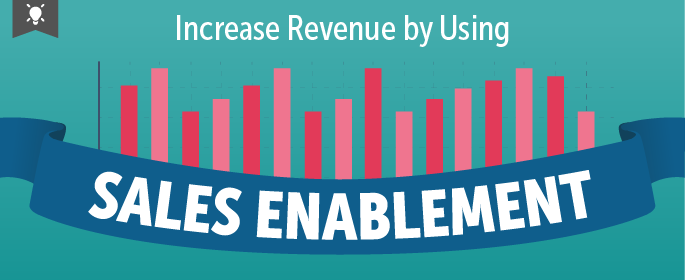
It’s pretty common for marketing and sales to function as two completely different departments. After all, our objectives appear to be very different: marketing generates leads, sales closes them. One is responsible for bringing in the bodies, the other for converting them into customers.
But what might it look like if your marketing and sales teams worked together, rather than separately?
Studies have shown that 50% of sales time is wasted on poor prospects.
And that’s frustrating for both parties, because it’s hard to pinpoint why that’s happening. Is sales disqualifying people too early? Are they just not following up enough times? Or is marketing not bringing in good quality leads or doing a good job of nurturing them to conversion?
I think we can all agree that it’s probably a little of all the above, depending on the situation.
But, at the same time, company leadership is coming down on both sales and marketing, like, “WHERE’S THE RESULTS?”
And when that happens, finger pointing is not a sufficient response.
So I ask again: What might it look like if your marketing and sales teams worked together, rather than separately?
It might look like everyone working together towards one common objective: increased revenue. Like everyone taking ownership for sales, because they know that, whether they get on the phone with a customer or not, they’re ultimately responsible for the business’s success. Like sales and marketing working as a team to make sure their prospects get the right message at the right time through the channel they’re looking for it in.
It sounds like a dream, but it’s also the result of sales enablement.
Sales enablement is the processes, content, and technology that allow sales teams to sell in higher quantities and at a faster pace.
But it’s not an effort that’s centralized in sales. Sales enablement is about sales and marketing working together.
I know what you’re thinking, “Shannon, that sounds great and all, but where do I get started?”
I got you, boo. Here are some steps to start implementing sales enablement in your business, so you can reap the rewards:
Identify your ideal client profile.
Sit down with both your marketing and sales teams and start mapping out your ideal client profiles and buyer personas. This will be helpful in making sure you’re targeting the right audience (and end that “marketing is sending me crap leads” accusation once and for all).
Remember, this is a marketing AND sales effort. To quote everyone’s favorite musical about high schools: “We’re all in this together.”

Marketing can pull demographic and behavioral data about customers and sales can provide insights based on their conversations and experiences selling customers on your products or services.
Determine core responsibilities of each department.
Not to negate what we just discussed about working together, but, as we know, sales and marketing have inherently different functions. So it’s important to differentiate which responsibilities fall on which team.
When we talked about that for our own internal marketing and sales efforts, we found that there were some things that created a general confusion, such as events. If we’re attending an event, whose responsibility is it to attend? To follow up? Who writes the emails and sets them up? If we’re hosting an event, who coordinates it? Is that a sales initiative or a marketing initiative?
Your team might be experiencing something similar, so take some time to sit down and outline the different ways that you are marketing to and connecting with your audience, then make a decision about which will fall under the sales umbrella and which will fall under marketing.
Pick your objectives.
You should have one main objective. This is what EVERYONE is going for. (Hint: It will probably involve revenue.) Decide on that together, then post in a place where you can all reference it. This is what you’re working towards as a team.
Then you’ll want objectives for each department, based on the responsibilities you outlined above.
So maybe your goal for marketing includes generating new leads or a certain number of sales qualified leads, meaning people who are closer to buying.
And maybe your goal for sales is a certain number of new clients sold or a specific revenue goal.
These objectives will help both teams keep their eye on and keep moving toward your main objective.
Define your SLA (service-level agreement).
Once you’re clear on what your goals and responsibilities are between departments, you’ll want to establish what’s called a service-level agreement, or SLA for short.
This is basically an agreement between two parties about an expectation.
Your marketing to sales SLA might be that marketing is going to only send super qualified leads.
And your sales to marketing SLA might be that leads are going to be contacted within 24 hours.
This outlines clear expectations as to what each party will provide, so there’s no misunderstandings and it’s easier to identify when someone isn’t holding up their end of the deal.
Paint the picture of a qualified lead.
If your marketing team is sending over every lead who’s filled out the contact form on your website, you might have a frustrated sales team that’s spending time connecting with unqualified leads.
It’s important to determine for your business what a qualified lead is. Use your ideal client profile to dig a little deeper.
What actions would they be taking that would signal that they are a qualified lead?
What would they be looking at or downloading?
What criteria might you want them to meet before they have a conversation with sales?
Write those things down and make sure that you’re passing off the right leads, not every lead.
Got leads that aren’t ready for sales yet? That’s where marketing automation and lead nurture come in. Using marketing automation software, you can pass of the qualified leads to sales while keeping the colder leads in a marketing funnel for nurture. When those leads start to meet your qualification criteria, you can shoot them on over to sales to connect.
Which leads us to our next point…
How are leads being nurtured?
Nurtured leads produce an average of a 20% increase in sales when compared to non-nurtured leads.
When a lead enters your marketing funnel and they’re not sales ready, what happens?
Do they receive content? If so, what kind of content? How frequently are they receiving it?
When’s the next time you try pushing them to the sale? What’s the offer in that message?
Are you segmenting your list and customizing messaging based on your buyer personas?
These are all things to consider as part of your lead nurturing process.
Figure out the hand off.
In every business that uses inbound marketing, there is that epic moment of the hand off. Imagine it like a relay race, and you’re passing on the baton. How is your team passing the baton?
When you have a qualified lead, how is marketing passing them over to sales?
If you’re using an automation platform, you have a couple options:
- You can set up lead scoring to identify marketing qualified leads (MQL) and sales qualified leads (SQL). When someone reaches SQL status, they get assigned to a sales rep.
- If there’s a qualifying action they take, such as submitting a Request a Quote form, you can set up an automation to assign them to a salesperson.
- If they’re already assigned a salesperson, you can trigger a notification to the sales rep when that contact is visiting your website, downloading an ebook, or watching your services video.
If you’re not in an automation platform, what are you waiting for??? Just kidding (kind of). You might be using a sales coordinator or sales support team to identify hot prospects for sales to follow up with.
The important thing here is to establish WHEN and HOW you will hand off qualified leads to the sales team.
Support sales with content.
95% of buyers buy from someone who gave them content at each stage of the buying process.
Did that just blow your mind?

But most sales teams don’t have what they need, or at least not in an accessible format, to send to prospects in follow up to conversations.
Here are some ways you can, as a marketer, support your sales team:
- Ask them what type of content would be helpful for their prospects. Do they need case studies? Videos? Testimonials? Ebooks?
- Discuss common questions their prospects have – are they curious about a certain product feature, or do they want to learn more about how to solve a specific problem? While sales can certainly answer those questions, you can help them by creating content around those topics.
- Create the content, based on what would be most helpful first, then working your way down the priority list.
- Determine the best way to store content for easy access. Can it be stored in your automation platform? Should it live on your internal server or on Google Drive?
- Look into opportunities to automate content and follow ups. If your platform is capable of automation, see how you can support your sales team by creating workflows that automatically send content and follow up emails to their prospects.
- Monitor the success of the content and automations to determine what can be optimized and what new content can be created to support sales efforts.
Maintain consistent communication.
As with all things business and marketing, this isn’t a one and done deal. You don’t have this conversation once, create supporting assets, then throw up the peace sign on your way out the door.
Sales enablement requires regular, ongoing conversation between your sales and marketing teams. Once a month minimum, twice a month preferred, but make sure to set aside time to get on the same page and see how you can continue to improve upon working together towards your common goal of increasing revenue for your company.
At the end of the day, sales enablement is just smarketing – smart marketing.
It’s not about finger pointing, blaming, or one department being better than the other. It’s about finally accepting that sales and marketing can’t exist without the other, and they function best as a cohesive unit.
Have questions about sales enablement or smarketing? Leave ‘em in the comments.





